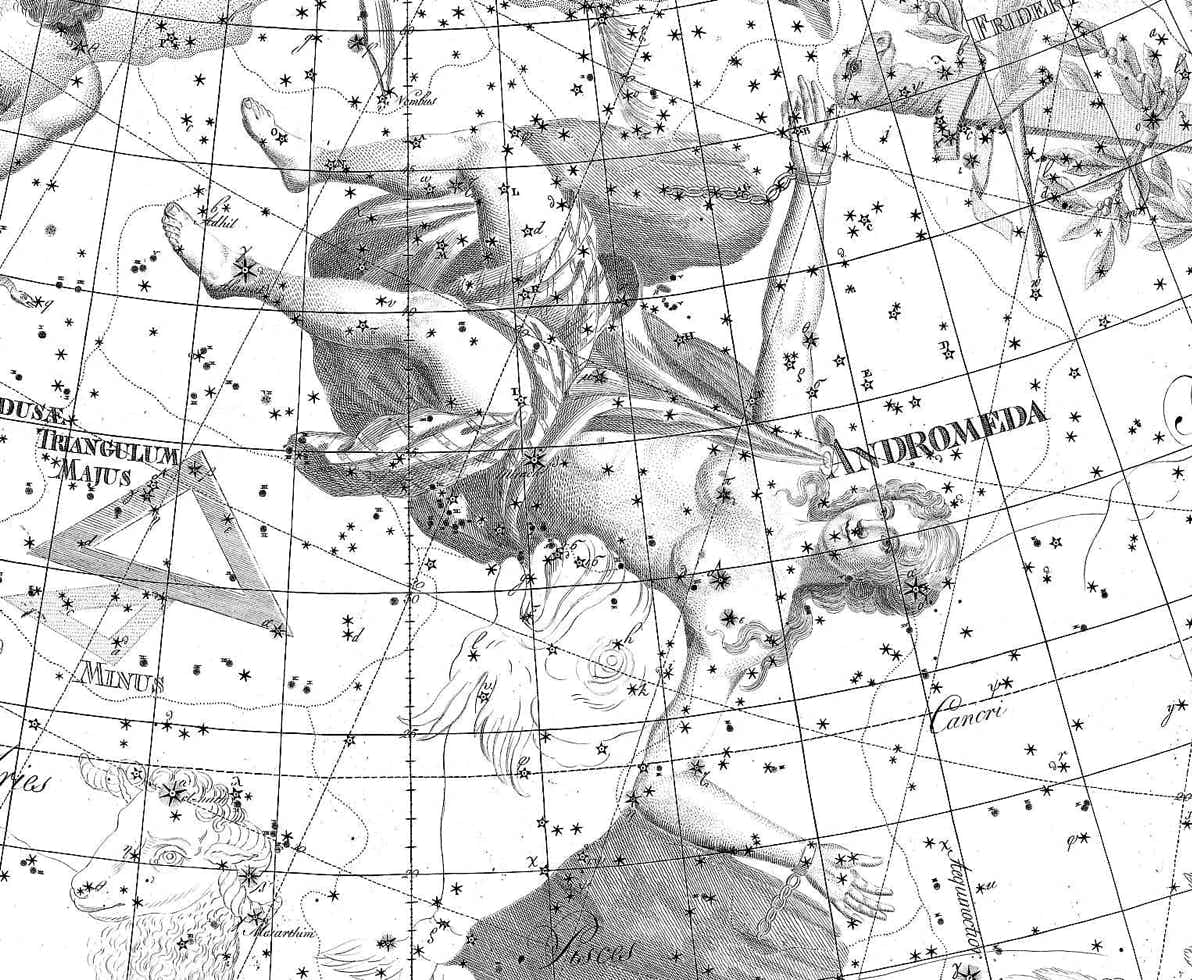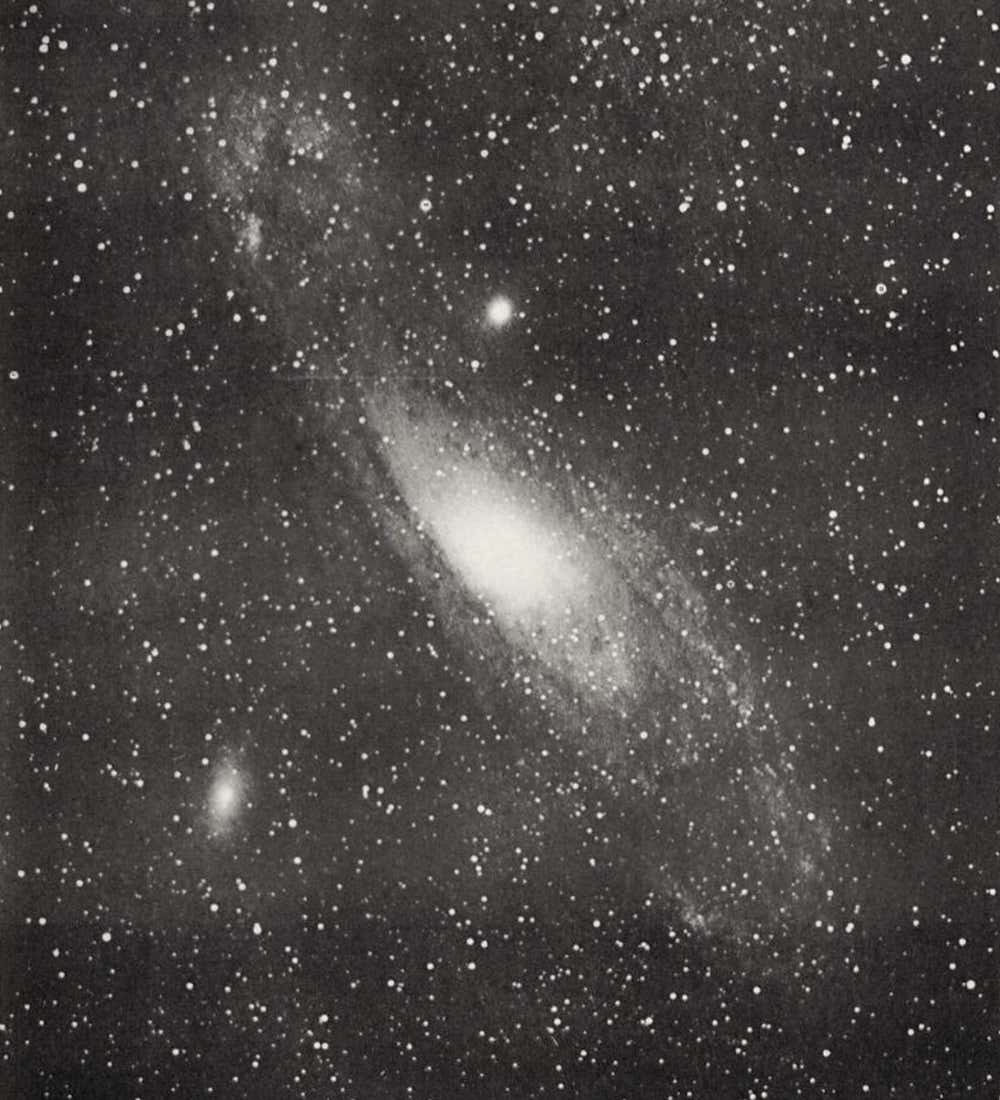
Genitive: Andromedae
Abbreviation: And
Size ranking: 19th
Origin: One of the 48 Greek constellations listed by Ptolemy in the Almagest
Greek name: Ἀνδρομέδα
Perhaps the most enduring of all Greek myths is the story of Perseus and Andromeda, the original version of George and the dragon. Its heroine is beautiful princess Andromeda (Ἀνδρομέδα in Greek). She was the daughter of the weak King Cepheus of Ethiopia and the vain Queen Cassiopeia, whose boastfulness knew no bounds.
Andromeda’s misfortunes began one day when her mother claimed that she was more beautiful even than the Nereids, a particularly alluring group of sea nymphs. The affronted Nereids decided that Cassiopeia’s vanity had finally gone too far and they asked Poseidon, the sea god, to teach her a lesson. In retribution, Poseidon sent a terrible monster (some say also a flood) to ravage the coast of King Cepheus’s territory. Dismayed at the destruction, and with his subjects clamouring for action, the beleaguered Cepheus appealed to the Oracle of Ammon for a solution. He was told that he must sacrifice his virgin daughter to appease the monster.
Hence the blameless Andromeda came to be chained to a rock to atone for the sins of her mother, who watched from the shore with bitter remorse. The site of this event is said to have been on the Mediterranean coast at Joppa (Jaffa), the modern Tel-Aviv. As Andromeda stood on the wave-lashed cliffs, pale with terror and weeping pitifully at her impending fate, the hero Perseus happened by, fresh from his exploit of beheading Medusa the Gorgon. His heart was captivated by the sight of the frail beauty in distress below.
Andromeda chained to a rock, depicted on Chart IV of the Uranographia of Johann Bode (1801). At upper right is the obsolete constellation Honores Friderici, introduced by Bode, which borrowed stars from Andromeda’s right hand.
The Roman poet Ovid tells us in his book the Metamorphoses that Perseus at first almost mistook her for a marble statue. Only the wind ruffling her hair and the warm tears on her cheeks showed that she was human. Perseus asked her name and why she was chained there. Shy Andromeda, totally different in character from her vainglorious mother, did not at first reply; even though awaiting a horrible death in the monster’s slavering jaws, she would have hidden her face modestly in her hands, had they not been bound to the rock.
Perseus persisted in his questioning. Eventually, afraid that her silence might be misinterpreted as guilt, she told Perseus her story, but broke off with a scream as she saw the monster breasting through the waves towards her. Pausing politely to ask the permission of her parents for Andromeda’s hand in marriage, Perseus swooped down, slew the sea-dragon with his diamond sword, released the swooning girl to the enthusiastic applause of the onlookers and claimed her for his bride. Andromeda later bore Perseus six children including Perses, ancestor of the Persians, and Gorgophonte, father of Tyndareus, king of Sparta.
The Greek goddess Athene is said to have placed Andromeda’s image among the stars, where she lies between Perseus and her mother Cassiopeia. Only the constellation Pisces, the fishes, separates her from the sea monster, Cetus.
Stars in Andromeda…
Star maps picture Andromeda with her hands in chains. Her head is marked by the second-magnitude star Alpha Andromedae, originally shared with neighbouring Pegasus. In fact, in the Almagest Ptolemy listed this star not under Andromeda but Pegasus, where it marked the horse’s navel, although he acknowledged that it was ‘common to the head of Andromeda’. The star is now assigned exclusively to Andromeda but echoes of its dual identity live on in its popular name of Alpheratz, which comes from the Arabic al-faras, meaning ‘the horse’. A now-obsolete alternative name for it was Sirrah, from the Arabic surrat, meaning ‘navel’, harking back to Ptolemy’s description of it as the navel of the horse.
The girl’s waist is marked by the star Beta Andromedae, called Mirach, a name corrupted from the Arabic al-mi’zar meaning ‘the girdle’ or ‘loin cloth’. Ptolemy described it as ‘the southernmost of the three stars over the girdle’ (the others were Mu and Nu Andromedae). Her left foot is marked by Gamma Andromedae, whose official IAU-approved name is Almach but which in the past has also been variously spelled Almaak, Alamak, or Almak, from the Arabic al-’anāq, referring to the desert lynx or caracal which the old Arabs visualized here. Through small telescopes this is a beautiful twin star of contrasting yellow and blue colours. The star that Ptolemy described as lying in Andromeda’s right foot is now just within the modern borders of Perseus, where it is known as Phi Persei.
…and a spiral galaxy
The most celebrated object in the constellation is the great spiral galaxy M31, positioned on Andromeda’s right hip, where it is visible as an elongated blur to the naked eye on clear nights. M31 is a whirlpool of stars similar to our own Milky Way. At a distance of around 2.5 million light years, the Andromeda Galaxy is the farthest object visible to the naked eye. The first recorded mention of this object is in the Book of the Fixed Stars by the Arabic astronomer al-Ṣūfī (AD 903–986). He called it al-laṭkhā al-saḥābiya, the nebulous smear (laṭkhā means smear or smudge, while saḥābi means nebula or cloud). Why Ptolemy and other ancient Greek astronomers never mentioned it is a mystery, as it should have been as easily visible to them as it was to the Arabs. See this separate page for more on al-Ṣūfī’s depiction of the Andromeda galaxy.
The spiral structure of the Andromeda Galaxy was first detected on a photograph taken on 1887 October 10 by the Welsh-born astronomer Isaac Roberts (1829–1904) using a 20-inch reflector at his private observatory near Liverpool. Further photographs confirmed the discovery, culminating on 1888 December 29 with this four-hour exposure. However, he did not realize the significance of what he had photographed, thinking that the spiral shape indicated it to be a forming planetary system. Roberts wrote: ‘The central sun is now seen in the midst of nebulous matter which in time will be either absorbed or further separated into rings. The farthest boundaries of the nebula have already separated into rings more or less symmetrical with the nucleus.’ It would be another 35 years before Edwin Hubble at Mount Wilson proved that the Andromeda spiral was a separate galaxy.
Chinese associations
In the Chinese constellation system, the elliptical shape formed by nine stars including Beta, Mu, Nu, Pi, Delta, Epsilon, Zeta, and Eta Andromedae, along with seven others over the border in Pisces, was called Kui; the same name was also given to the 15th lunar mansion. The meaning of Kui is somewhat puzzling. According to one interpretation, it has to do with legs, feet, or walking, possibly because its shape resembles that of a foot or sandal; perhaps it is the rear legs or feet of the White Tiger. As a result, the Chinese name is often seen translated as ‘legs’ or ‘stride’. Alternatively, Kui was said to represent a wild boar.
Alpha Andromedae was joined with Gamma Pegasi to form Bi, the eastern wall of the Emperor’s palace grounds, also said to represent the Emperor’s private reference library. The 14th lunar mansion was named Bi, ‘wall’, after this pairing. (Confusingly, the 19th lunar mansion, in Taurus, is also called Bi but there it has a different meaning.)
Gamma Andromedae and ten nearby stars were known as Tian Dajiangjun, representing the great general of the heavens and ten subordinate officers. Ten stars in the north and centre of Andromeda formed Tianjiu, a stable for despatch riders to change horses on a pony express route; the stars’ identifications are uncertain but probably included Theta, Rho, and Sigma Andromedae plus a loop of fainter stars to the west. Other stars in western Andromeda, including the modern-day 7, Lambda, Psi, Kappa, and Iota, were part of Tengshe, a flying serpent, which was centred in neighbouring Lacerta.
Some sources identify Phi Andromedae as Junnanmen, the southern gate to the headquarters of Tian Dajiangjun; however, this star is too far north to be described as a southern gate, and Alpha Trianguli seems a better fit to the position.
© Ian Ridpath. All rights reserved
Isaac Roberts’s photograph of the Andromeda Galaxy (which he described as a nebula) taken on 1888 December 29 with a 4-hour exposure through his 20-inch reflector. This picture was published in his book A Selection of Photographs of Stars, Star Clusters and Nebulae (1893). Click on the image for a full-size scan.




